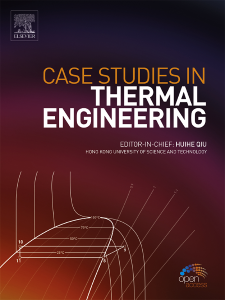Performance study of solar air collector-air source heat pump system inside the greenhouse
IF 6.4
2区 工程技术
Q1 THERMODYNAMICS
引用次数: 0
Abstract
During the process of heating greenhouses, the phenomenon of inadequate heating installations is widespread. To address this issue, this paper proposed a solar air collector-air source heat pump (SAC-ASHP) system for greenhouses, combining solar technology with heat pump (HP) technology to provide sufficient heat during continuous cloudy days and winter. The heating capacities of the system on sunny, cloudy, and overcast days were 100.2 kWh, 112.3 kWh, and 157.8 kWh, respectively. The corresponding power was 30.1 kWh, 36.1 kWh, and 53.6 kWh. The coefficient of performance (COP) of the single air source heat pump (ASHP) for these days was 3.4, 3.2, and 3.0, respectively, while the COP of the solar heat pump (SHP) was 4.0, 3.5, and 3.1. Additionally, greenhouse employed heat and moisture recovery for humid air, aiming to provide a suitable environment for plant growth around the clock while conserving energy. The heat collection in the heat and moisture recovery combined HP mode was 66.7 % higher than in the heat exchanger (HE)-fan mode. This experimental study investigated the operational performance of the system in dynamic environments, revealing the stability of the system for greenhouse heating in cold regions, and providing new research ideas for greenhouse heating.
温室内太阳能空气集热器-空气源热泵系统的性能研究
在温室大棚供暖过程中,普遍存在供暖装置不足的现象。针对这一问题,本文提出了一种用于温室的太阳能空气集热器-空气源热泵(SAC-ASHP)系统,将太阳能技术与热泵(HP)技术相结合,在连续阴天和冬季提供充足的热量。该系统在晴天、阴天和多云时的供热能力分别为 100.2 千瓦时、112.3 千瓦时和 157.8 千瓦时。相应的功率分别为 30.1 千瓦时、36.1 千瓦时和 53.6 千瓦时。在这些日子里,单一空气源热泵(ASHP)的性能系数(COP)分别为 3.4、3.2 和 3.0,而太阳能热泵(SHP)的性能系数(COP)分别为 4.0、3.5 和 3.1。此外,温室还采用了湿热回收技术,目的是在节约能源的同时,为植物提供全天候的适宜生长环境。热量和水分回收组合 HP 模式的集热量比热交换器(HE)- 风机模式高 66.7%。这项实验研究调查了该系统在动态环境下的运行性能,揭示了该系统在寒冷地区温室供暖的稳定性,为温室供暖提供了新的研究思路。
本文章由计算机程序翻译,如有差异,请以英文原文为准。
求助全文
约1分钟内获得全文
求助全文
来源期刊

Case Studies in Thermal Engineering
Chemical Engineering-Fluid Flow and Transfer Processes
CiteScore
8.60
自引率
11.80%
发文量
812
审稿时长
76 days
期刊介绍:
Case Studies in Thermal Engineering provides a forum for the rapid publication of short, structured Case Studies in Thermal Engineering and related Short Communications. It provides an essential compendium of case studies for researchers and practitioners in the field of thermal engineering and others who are interested in aspects of thermal engineering cases that could affect other engineering processes. The journal not only publishes new and novel case studies, but also provides a forum for the publication of high quality descriptions of classic thermal engineering problems. The scope of the journal includes case studies of thermal engineering problems in components, devices and systems using existing experimental and numerical techniques in the areas of mechanical, aerospace, chemical, medical, thermal management for electronics, heat exchangers, regeneration, solar thermal energy, thermal storage, building energy conservation, and power generation. Case studies of thermal problems in other areas will also be considered.
 求助内容:
求助内容: 应助结果提醒方式:
应助结果提醒方式:


